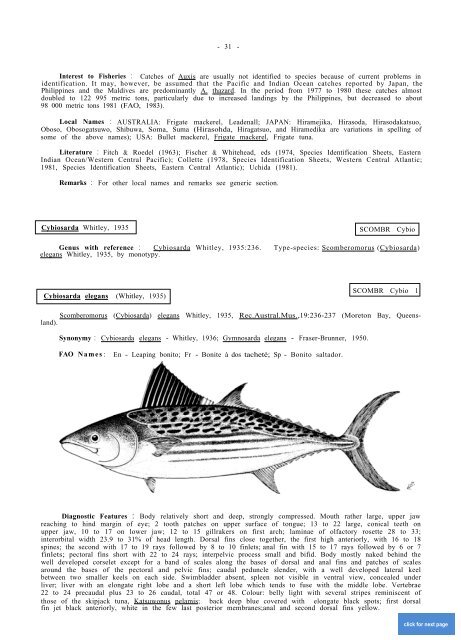FAO SPECIES CATALOGUE - si-pddr
FAO SPECIES CATALOGUE - si-pddr
FAO SPECIES CATALOGUE - si-pddr
Create successful ePaper yourself
Turn your PDF publications into a flip-book with our unique Google optimized e-Paper software.
- 31 -<br />
Interest to Fisheries : Catches of Auxis are usually not identified to species because of current problems in<br />
identification. It may, however, be assumed that the Pacific and Indian Ocean catches reported by Japan, the<br />
Philippines and the Maldives are predominantly A. thazard. In the period from 1977 to 1980 these catches almost<br />
doubled to 122 995 metric tons, particularly due to increased landings by the Philippines, but decreased to about<br />
98 000 metric tons 1981 (<strong>FAO</strong>, 1983).<br />
Local Names : AUSTRALIA: Frigate mackerel, Leadenall; JAPAN: Hiramejika, Hirasoda, Hirasodakatsuo,<br />
Oboso, Obosogatsuwo, Shibuwa, Soma, Suma (Hirasohda, Hiragatsuo, and Hiramedika are variations in spelling of<br />
some of the above names); USA: Bullet mackerel, Frigate mackerel, Frigate tuna.<br />
Literature : Fitch & Roedel (1963); Fischer & Whitehead, eds (1974, Species Identification Sheets, Eastern<br />
Indian Ocean/Western Central Pacific); Collette (1978, Species Identification Sheets, Western Central Atlantic;<br />
1981, Species Identification Sheets, Eastern Central Atlantic); Uchida (1981).<br />
Remarks : For other local names and remarks see generic section.<br />
Cybiosarda Whitley, 1935 SCOMBR Cybio<br />
Genus with reference : Cybiosarda Whitley, 1935:236. Type-species: Scomberomorus (Cybiosarda)<br />
elegans Whitley, 1935, by monotypy.<br />
Cybiosarda elegans (Whitley, 1935)<br />
Scomberomorus (Cybiosarda) elegans Whitley, 1935, Rec.Austral.Mus.,19:236-237 (Moreton Bay, Queensland).<br />
Synonymy : Cybiosarda elegans - Whitley, 1936; Gymnosarda elegans - Fraser-Brunner, 1950.<br />
<strong>FAO</strong> Names: En - Leaping bonito; Fr - Bonite à dos tacheté; Sp - Bonito saltador.<br />
SCOMBR Cybio 1<br />
Diagnostic Features : Body relatively short and deep, strongly compressed. Mouth rather large, upper jaw<br />
reaching to hind margin of eye; 2 tooth patches on upper surface of tongue; 13 to 22 large, conical teeth on<br />
upper jaw, 10 to 17 on lower jaw; 12 to 15 gillrakers on first arch; laminae of olfactory rosette 28 to 33;<br />
interorbital width 23.9 to 31% of head length. Dorsal fins close together, the first high anteriorly, with 16 to 18<br />
spines; the second with 17 to 19 rays followed by 8 to 10 finlets;;anal fin with 15 to 17 rays followed by 6 or 7<br />
finlets; pectoral fins short with 22 to 24 rays; interpelvic process small and bifid. Body mostly naked behind the<br />
well developed corselet except for a band of scales along the bases of dorsal and anal fins and patches of scales<br />
around the bases of the pectoral and pelvic fins; caudal peduncle slender, with a well developed lateral keel<br />
between two smaller keels on each <strong>si</strong>de. Swimbladder absent, spleen not vi<strong>si</strong>ble in ventral view, concealed under<br />
liver; liver with an elongate right lobe and a short left lobe which tends to fuse with the middle lobe. Vertebrae<br />
22 to 24 precaudal plus 23 to 26 caudal, total 47 or 48. Colour: belly light with several stripes reminiscent of<br />
those of the skipjack tuna, Katsuwonus pelamis; back deep blue covered with elongate black spots; first dorsal<br />
fin jet black anteriorly, white in the few last posterior membranes;anal and second dorsal fins yellow.<br />
click for next page
















